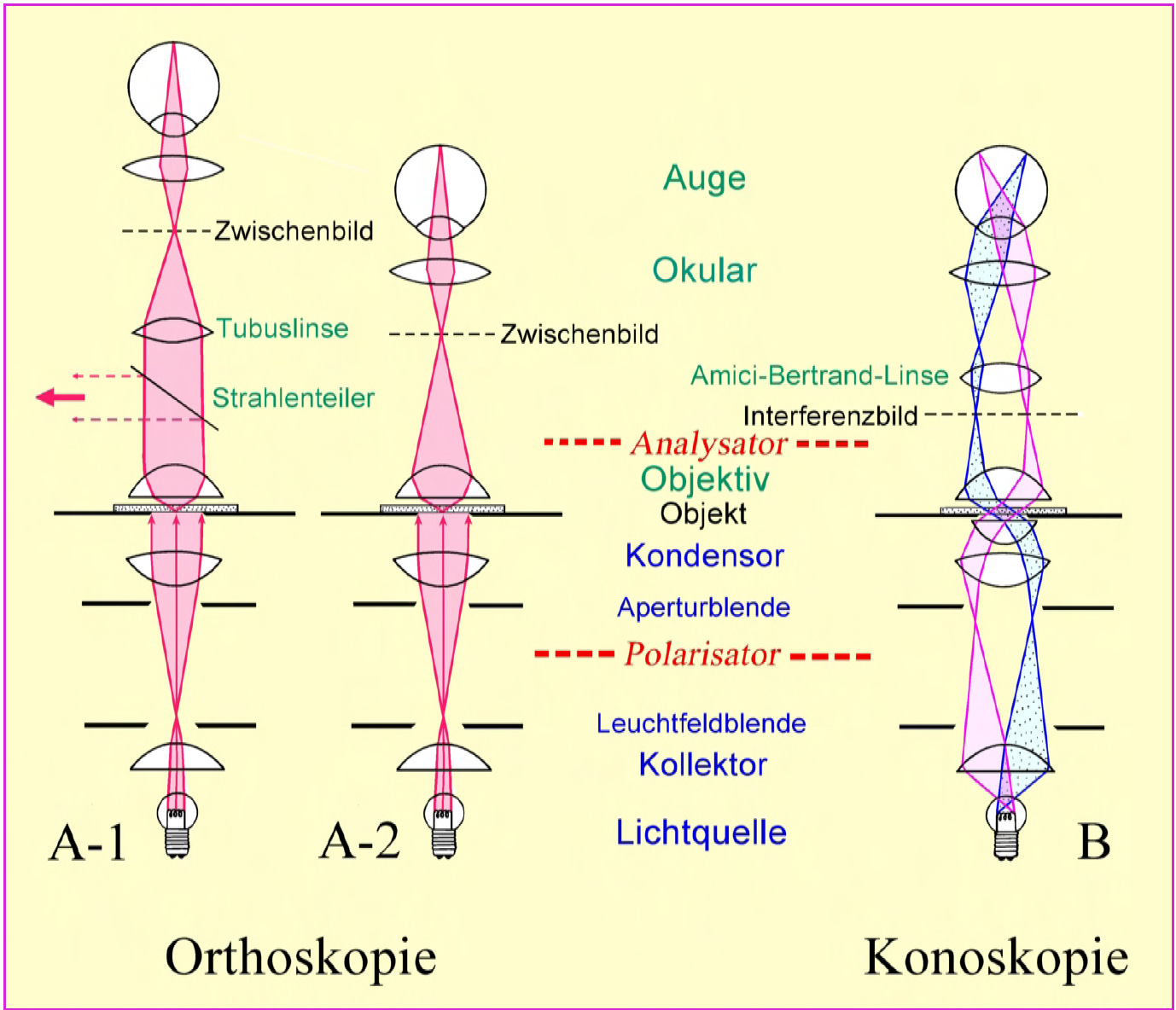Polarized light microscopy
Authors: Hans-Jürgen Schwarz, Anika Husen
back to Analysis of Salts
Abstract[edit]
The determination of salts with the polarized light microscope method is briefly described, then the advantages and disadvantages are listed.
Introduction[edit]
Polarization microscopy [Wuelfert:1999]Title: Der Blick ins Bild
Author: Wülfert, Stefan is used especially for the examination of anisotropic (birefringent) objects [1]. Compared to the ordinary microscopes, the polarization microscope has a polarizing filter (polarized light) added to the light path beneath the sample slide. Through this polarizer the object is illuminated with linearly polarized light. Another polarizing filter (analyzer) is situated in the observation beam path allowing for the analysis of the linearly polarized light, modified by the object. When using crossed polarizers (polarizer and analyzer) without an object ( 90° difference in the vibration plane of each kind of transmitted light) only darkness should be visible. In polarized light microscopy the direct (orthoscopic) or indirect (conoscopic) approach can be applied.
is used especially for the examination of anisotropic (birefringent) objects [1]. Compared to the ordinary microscopes, the polarization microscope has a polarizing filter (polarized light) added to the light path beneath the sample slide. Through this polarizer the object is illuminated with linearly polarized light. Another polarizing filter (analyzer) is situated in the observation beam path allowing for the analysis of the linearly polarized light, modified by the object. When using crossed polarizers (polarizer and analyzer) without an object ( 90° difference in the vibration plane of each kind of transmitted light) only darkness should be visible. In polarized light microscopy the direct (orthoscopic) or indirect (conoscopic) approach can be applied.
The orthoscopic approach corresponds to the ordinary microscopy. When the analyzer is switched on anisotropic bodies appear. Depending on their orientation, thickness and the value of the birefringence[2][3][4] anisotropic bodies appear in the interference color that corresponds to the path difference between ordinary and extraordinary rays.

B: In the conoscopic beam path (pupillary light pathway), however, the reproduction of parallel light beams of the light cone, which is in the upper focal plane of the lens, takes place. The developing interference image (in the case of anisotropic crystals) can be magnified with an Amici- Bertrand- Lens. If no Amici-Bertrand lens is present, the interference image can also be seen through a diopter that can be inserted into the tube instead of the eyepiece.[Raith.etal:2009]Title: Leitfaden zur Dünnschliffmikroskopie
Author: Raith, Michael M.; Raase, Peter

Conoscopic approach: By switching on an additional lens (Amici-Bertrand lens) or by removal of an eyepiece, the back focal plane of the objective is pictured in the intermediate image plane, seen through the eyepiece. While in the orthoscopic approach every image point corresponds to an object point, in the conoscopic approach every image point corresponds to a parallel beam of light. Therefore the image gives information about the directionality of the birefringence (as far as it can be detected by the aperture). Consequently, this method allows to determine whether a crystal is optically uniaxial or biaxial and whether it is optically positive or negative. The light refraction of salt minerals can be estimated relatively easily, when the refraction of the immersion medium or oil is known.
For a detailed description of microscopic mineral analysis see [Raith.etal:2009]Title: Leitfaden zur Dünnschliffmikroskopie
Author: Raith, Michael M.; Raase, Peter .
.
Advantage:
Polarized light microscopy is a quick and convenient method for the determination of salts. The mineralogy and chemistry of salts is determined. Basic polarizing microscopes are portable and can be used in any location, hence sensitive salts can be identified on site.
Disadvantage:
Some salts are difficult to identify. Quantitative identification is not possible.
Weblinks[edit]
- ↑ http://www.microscopy-uk.org.uk/mag/artnov08/rd-crystals.html, gesehen 19.11.2009
- ↑ http://e3.pphysik.uni-dortmund.de/~suter/Vorlesung/Physik_B3_SS03/6.5_Polarisation.pdf, gesehen 19.11.2009
- ↑ http://www.gemmologie.at/mediaCache/Doppelbrechung_270385.pdf, gesehen 19.11.2009
- ↑ http://www.physik.uni-jena.de/inst/iao/applets/doppelbrechung/doppelbrechung.html, gesehen 19.11.2009
- ↑ http://www.igw.uni-jena.de/mineral/downloads/polarisationsmikr.pdf gesehen 16.07.2010
Literature[edit]
| [McCrone.etal:1984] | McCrone, W. C.,; McCrone, L. B. ; Delly, J. G. (1984): Polarized light microscopy, McCrone Research Institute, Chicago, 9th ed. 1995 |  |
| [Raith.etal:2012] | Raith, Michael M.; Raase, Peter; Reinhardt, Jürgen (2012): Guide to Thin Section Microscopy, Second Edition, online publication, Url, |  |
| [Wuelfert:1999] | Wülfert, Stefan (1999): Der Blick ins Bild, Ravensburger Buchverlag |  |